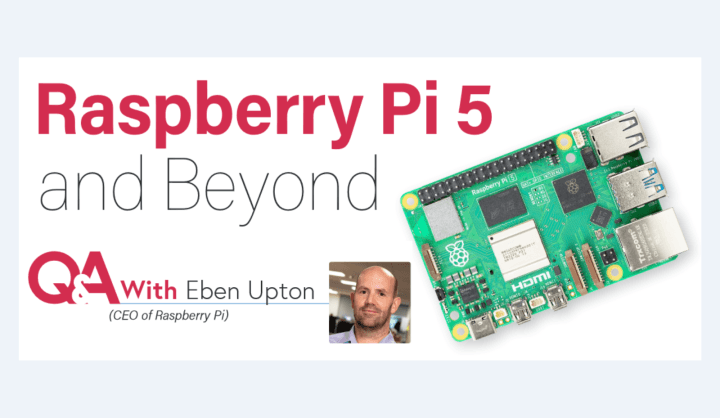Eben Upton on the Raspberry Pi 5 and Beyond
on

Jean-Francois Simon, Elektor: The Raspberry Pi 5 has been out for a few months now. How are the sales going?
Eben Upton: Very well. We’re closing in on shipping our first million units. This is a little slower than the Raspberry Pi 4, and has been limited by production until very recently. Kudos to the team at Sony for getting us to a production rate of 90,000 units per week. [Editor's Note: The Sony UK Technology Centre in Pencoed, Wales, manufactures Raspberry Pi boards.] We won’t need to stay there forever, but it gives us a chance to catch up with demand and to start to build a little inventory.
JF: Have you seen exciting projects made with the Raspberry Pi 5, that would have been harder to make with any prior versions, and that made you particularly proud you released it?
Eben: I think, for me, the most exciting thing about Raspberry Pi 5 is that we’ve finally produced the “no compromises” desktop PC experience that we’ve been chasing since the launch of the very first Raspberry Pi in 2012. You see people (my daughter included) using Raspberry Pi 5 as their “daily driver” computer without ever feeling held back by it. The addition of a single-lane PCIe “user port” is also opening up new opportunities for experimentation. We’ve been watching with interest as Jeff Geerling tries to get his giant collection of PC graphics cards up and running with Raspberry Pi 5.
JF: Do you have interesting or funny anecdotes about things that happened during the development of the Raspberry Pi 5, and that you may be able to share now that it’s out?
Eben: What people don’t appreciate about Raspberry Pi 5 is how long it’s been in development. The first ASIC team members started work on the RP1, then called Project X, in the summer of 2015. [Editor’s Note: The RP1 is a custom southbridge, designed in-house by Raspberry Pi, which provides the majority of the I/O capabilities for the Raspberry Pi 5.] So that’s an eight-year program, started at a company that was less than three years old at the time! One of the fun things about working at Raspberry Pi is that we can make these really long-term bets and watch them pay off.
JF: In the early 2010s, when you were working on the first Raspberry Pi, one of the main goals was to promote the study of computer science, get people to roll up their sleeves and program, and understand how it works. Now there are tools such as ChatGPT that can generate code for you, which mostly works if it’s given some guidance. Do you think that this kind of tool can make people more and more intellectually lazy? How do you feel about these tools?
Eben: I’m not sure I agree that ChatGPT can currently generate production-quality code even with “some guidance.” But, in any case, I don’t think they make people lazy or put people out of work: We’ve been designing tools (assemblers, compilers, higher-level languages) that have increased productivity since the dawn of the computer age in the 1940s, and they mostly have the effect of increasing demand for computer programmers (see Jevon’s Paradox)! The term for carefully asking ChatGPT to write you some Python is “computer programming:” it’s just programming in a different — and, unfortunately, less precise — language.
JF: In the 1980s, many young enthusiasts cut their teeth on programming with BASIC on systems such as the BBC Micro. Today, Raspberry Pi champions Python as the go-to language for beginners. How do you think this shift in starting languages influences the learning experience and approach for young programmers today?
Eben: I think it’s very motivational for young programmers to be given a language that combines the low barrier to entry of BASIC with the high ceiling of a “proper” programming language. Any time you ask someone to change, between computers, or between languages, there’s always a chance they just say “no,” and stop. So getting students to use Python, which is a very beginner-friendly language, and telling them that they are writing “hello world” in the same language that professional engineers use to build enterprise software is very valuable.
JF: You mentioned in the past that it was difficult to integrate hardware-based AI in any Raspberry products, because it’s expensive, and doing so would have taxed users who don’t need it in favor of a certain percentage of people who will maybe use it. Anyway, AI often needs beefy GPUs in order to make interesting things happen, which is not practical on a Raspberry Pi. Could you share your thoughts about AI, and how AI and Raspberry Pi products can work nicely together?
Eben: If you accept my suggestion that we want to do a good job for AI workloads, but can’t tax non-AI-centric users with dedicated acceleration hardware, I think there are two natural consequences for system design: We end up adding a lot of CPU performance, so low-to-mid-end inference workloads can be run on the CPU (we deliver this with our quad-2.4 GHz A76s on Raspberry Pi 5, and our dual 133 MHz M0+s on RP2040 for TinyML), and fast interfacing to talk to accelerators for high-end workloads (USB 3 on Raspberry Pi 4 and 5, PCIe on Raspberry Pi 5).
JF: Just after the Raspberry Pi 5 launch, many press articles were published about the differences between the 4 and the 5. Personally, what is your favorite new feature?
Eben: Honestly, the performance. As I say, it’s the first Raspberry Pi that I sit down in front of and find myself forgetting that I’m not using a legacy Intel PC.
JF: Now that Bloomberg has broken the news about the possible initial public offering, and Raspberry Pi shares being sold to investors, some hobbyists and makers have been sharing concerns on Reddit, X (formerly Twitter), etc. Will you be able to maintain your community-focused ethos in the face of pressures that come with being a publicly traded company?
Eben: It’s early days in our exploration of the possibility of an IPO, but I’m certain we could. You have to remember we’re already highly incentivized to make great, cost-effective products (because we’re geeks, and want to make the products we want to buy), and to make money (because the profits from Trading fund the Foundation, which we care deeply about). So, our incentives wouldn’t change post-IPO, and I struggle to see why our behavior would. Ultimately, though, the proof of the pudding is in the eating. Come back in five years, and see how we’re getting on.

JF: Switching topics, the RP2040 is three years old now. Any plans to expand your microcontroller range with other products anytime soon?
Eben: I think we understand what people love about RP2040: the comparatively high integer performance, large memory, and flexible I/O. And we understand where the deficiencies are: comparatively high standby current, lack of floating-point and DSP support, and lack of a security model or on-chip non-volatile storage. So there’s an obvious specification there for a successor device, and we’ll be looking very carefully at how we might deliver that.
JF: After the success of the Raspberry Pi 400, will there be a Raspberry Pi 500 based on the Raspberry Pi 5 hardware?
Eben: Nothing to announce yet, but Raspberry Pi 400 has been a great success for us, and we’d love to bring Raspberry Pi 5 performance to that form factor.
JF: I heard there are official Raspberry Pi stores in Cambridge and Leeds. This is great! Could you tell us more about how they’ve been doing, and who are the main customers? I’m sure these stores are great for engaging with new customers, but do you also see people walking in and buying larger volumes of products for their professional needs? Do you have plans to open more of these brick-and-mortar shops?
Eben: The Cambridge store was solidly profitable in 2023, and our short-duration pop-up stores also do very good business. Leeds is loss-making at the moment, but we know that it takes time to grow a customer base, and we can afford to be patient. I don’t think we’re going to open stores on Apple’s scale, but you might see a very gradual expansion, with a new store opened as the previous store reaches profitability. Probably on in the UK for now, but in the longer term who knows?
JF: Thank you very much for your time and for this interview. I’m sure it will be of great interest to our readers. We wish you great success at Raspberry Pi for 2024 and beyond.
Eben: Thank you!
This interview (240145-01) with Eben Upton appears in ElektorMag May/June 2024. Watch another interview with Eben Upon below.








Discussion (0 comments)